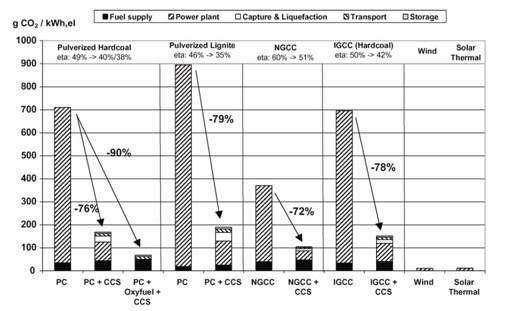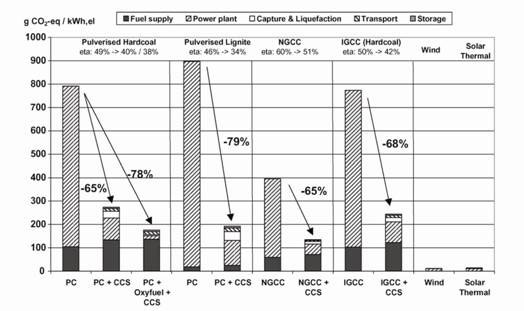A study commissioned by the German federal government finds carbon capture and storage emits ten to forty times as much greenhouse gases as wind or solar energy and gives no protection against the rising cost of fossil fuels Dr. Mae-Wan Ho
The study commissioned by the German federal government and led by researchers at the German Aerospace Center in Stuttgart compared carbon capture and storage (CCS) with renewable energy technologies using a combined lifecycle analysis and cost assessment for Germany [1].
The results show that per KWh of electricity generated, CCS cuts CO2 emissions by 72-90 percent, and total greenhouse gas emissions by 65-79 percent, assuming that the technology works as planned and the geologically stored CO2 does not leak out at all; any leakage would compromise the mitigating potential of CCS. However, the net emissions from CCS are still 10 to 40 times those from renewable energies such as solar and wind (see Figs. 1 and 2).

Figure 1. Carbon dioxide emissions for coal and natural gas power stations with and without CCS compared with renewable wind and solar

Figure 2. Greenhouse gas emissions for coal and natural gas power stations with and without CCS compared with renewable wind and solar
The difference between CO2 and greenhouse gas emissions comes from the methane released when coal is mined; and methane has a global warming potential about 20 times that of CO2. If companies take steps to prevent the release of methane and capture it for use in combined heat and power generation plants, then the advantage gained is equivalent to fitting CCS for lignite power plants.
Assuming that CCS could be fitted to new IGCC and Natural Gas Combined Cycle (NGCC) plants by 2020, electricity would end up costing roughly twice as much as without CCS. While renewables are currently more costly, the improvements in technology would bring the price of electricity from offshore wind plants for example to half the price of fossil fuel plants with CCS. The advantage of solar and wind energies is that they are immune from price increases of fossil fuels.
The assumption that the first commercially operated power plant with CCS will be operating by 2020 is built in to the study because Germany faces the problem that a large number of its fossil power plants are reaching the end of their life in the next 15 years. So, only if CCS technology can be retrofitted by 2020 would it stand a chance of delivering the climate protection goal of reducing greenhouse gas emissions at all.
Unfortunately, CCS remains unproven as a technological package. The earliest possible deployment is 2030 according to the World Business Council for Sustainable Development, while the Intergovernment Panel for Climate Change does not expect CCS to be commercially viable before the second half of the present century (see [2] Carbon Capture and Storage, A False Solution, SiS 39).
When further impacts are factored in [1] CCS increases photo-oxidants (that damage DNA), eutrophication (that destroy aquatic life), acidification (that damage trees and other plant life), and toxicity to humans, all by about 40 percent.
Article first published 11/07/08
Comments are now closed for this article